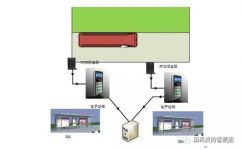
Application of RFID in buses and platforms
[ad_1]
The construction of a digital city is a complex systematic project involving government affairs, public utilities, transportation, communities and other aspects. Population management and social welfare management need to keep the detailed information of a large number of residents, water, electricity management, and traffic management need convenient payment methods and consumption data. Such a large amount of data collection, statistics, and query work have become the crux of the existing urban management methods, and RFID Technology can conveniently digitally record citizens’ life information and consumption information and reflect them in the relevant information system of the city, providing necessary data and analysis for the comprehensive management of city information.

The traditional electronic bus stop sign system uses on-board GPS to implement vehicle stop reporting. After years of operation, three challenges are faced in practical applications:
1) Large investment and high operating cost. Each vehicle needs to invest in on-board GPS+GPRS, and a monthly SIM card communication traffic fee is required. Due to the large number of vehicles, this operating cost is high.
2) The power consumption is large, and the battery of the bus is lost, causing the entire GPS station reporting system to be paralyzed.
3) GPS cannot work accurately on rainy days.
The RFID electronic stop sign adopts active RFID technology. By installing an RFID reader on the electronic stop sign and installing an RFID electronic tag on the vehicle, when the bus passes the station, the station actively recognizes the bus RFID electronic tag data and transmits it to the control center as a report Basic data for functions such as stations.
The use of RFID electronic stop sign technology has low overall cost, stable performance, does not incur any costs, is not affected by rain and fog, and greatly reduces the operating cost of electronic stop signs.
1. The basic concept of RFID
RFID is an automatic identification technology that uses induction, radio waves or microwave energy for non-contact two-way communication to realize the purpose of identifying and exchanging data. It automatically recognizes the target object and obtains related data through radio frequency signals. It can complete information input and processing without manual contact, optical visualization, and manual intervention, and the operation is quick and convenient. Electronic tags are different from barcodes. They are waterproof, antimagnetic, high temperature resistant, long service life, long reading distance, data on the tag can be encrypted, data storage capacity is larger, high-speed moving objects can be identified and multiple tags can be identified at the same time Etc.
The RFID system should include at least the following two parts, one is the reader, and the other is the electronic tag (or radio frequency card). In addition, antenna, host, etc. should also be included.

2. System structure
The system consists of RFID vehicle electronic tags, station RFID readers and electronic stop sign backend system.
The RFID vehicle electronic tag is installed on the bus, and the bus ID information is written inside; the RFID reader is installed at the station, and is connected to the electronic stop sign main control unit through the RS485 interface or RJ45 interface, reads the vehicle electronic tag information, and passes the vehicle. The situation is judged, and the vehicle information is transmitted to the electronic stop sign master control unit, and the electronic stop sign master control unit transmits the data back to the business system platform through the 4G wireless network.
3. Introduction to the principle of vehicle driving direction algorithm
As shown in the figure below, two readers 1, 2 and communication gateways are installed at each station. When the vehicle passes through the station, it is read by RFID readers 1 and 2 successively, and the read electronic tag data is processed through the communication gateway through the algorithm, and the vehicle entry record is output. .
The basic judgment logic principle is as follows:
When a vehicle enters the station, the reader 1 will read it first, and then the reader 2 will read it, then it can be judged that the vehicle has entered the station
If it is an oncoming vehicle, it will be read by reader 2 first, and then by reader 1. Can be filtered out.
In practical applications, the built-in algorithm of the communication gateway needs to deal with various possible situations and output the correct vehicle entry records.

4. Technological innovation and breakthrough points
The RFID (Radio Frequency Identification) technology is applied in the BRT priority system, and the technical advantages of RFID: not affected by harsh environments, good penetration, repeated use of electronic tags, long-distance non-contact The recognition and reading speed is fast, and the data can be updated, etc., which makes the effective linkage between the bus and the signal light, and improves the efficiency of the bus operation.
[ad_2]



